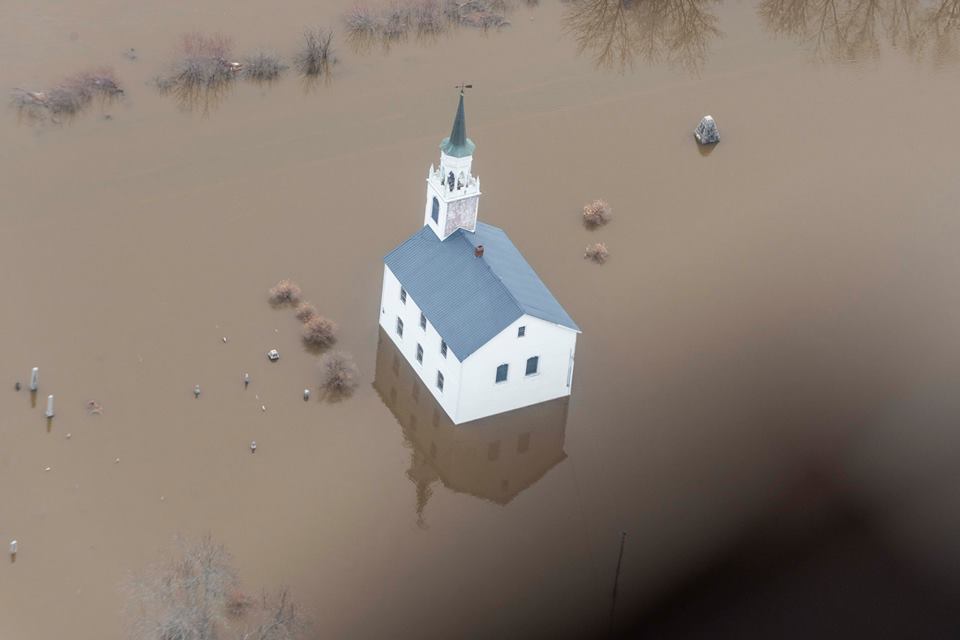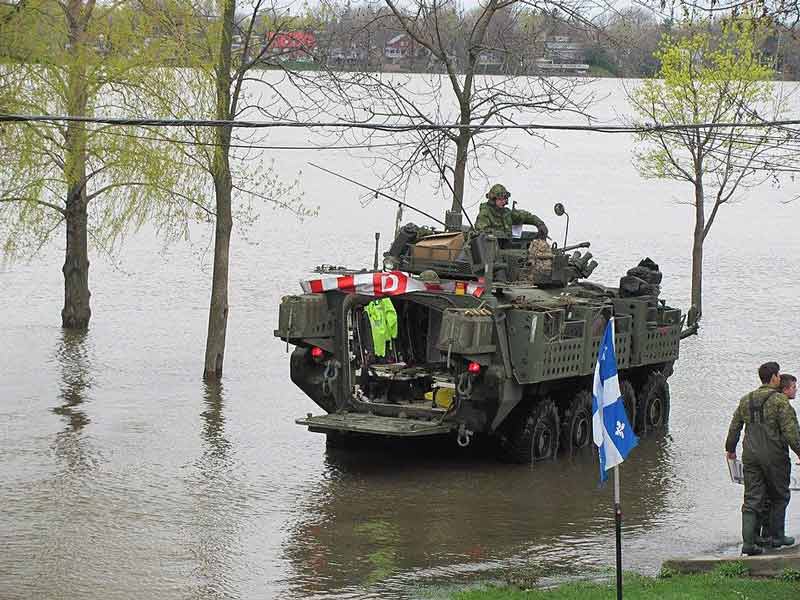
But within a span of the evening, rainfall spread to southern Quebec and New Brunswick—and would be on and off again until early May.
By April 20, however, coupled with gusty winds between 90-100 km/h, the rainfall had totalled from 35 to 60 millimetres.
These supposedly “heftier” spring showers, though, also came with a massive warm front.
Combined with the melt of an unusually high snowpack there was significant flooding in the region—or what’s effectively known as a “hundred-year flood.” It was the second such flooding to hit Eastern Canada in a span of two years.
The CAF deployed more soldiers, sailors and aviators to the three provinces than they did overseas.
According to Statistics Canada, about 17,500 dwellings were flooded or at risk of flooding from April 19 onward, with stretches of roads and farmlands impacted to varying degrees. As thousands of families were displaced, the Insurance Bureau of Canada (IBC) stated that the floods caused close to $208 million in damages.
“It’s discouraging, hard on the morale, hard on the family,” Eddy Girard of Île Bigras, Que., told The Toronto Star. “Do we rebuild, do we let it go?”
Tragically, one person, Louise Seguin Lortie, 72, died after her car fell into a sinkhole caused by the flood water just 30 kilometres northwest of Ottawa.
Although four years have passed, some have forgotten the significant role the Canadian Armed Forces played in helping the affected communities.
From April 19 to June 5, the CAF deployed more soldiers, sailors and aviators to the three provinces than they did overseas at the time. In total, about 2,500 personnel provided flood relief services, including helping residents evacuate, providing transportation and clearing routes.
Journalist Kat Eschner wrote in The Guardian that “news footage showed people boating where they once walked” and “homes and cars filled with muddy water.”
Important transportation routes closed due to flooding, including Ottawa’s Chaudière Bridge, which is used by 19,000 vehicles and 1,350 cyclists daily, and a major section of Trans-Canada Highway. In New Brunswick alone, more than 80 roads were shut down. Thankfully, though, the CAF was there to provide some residents with a temporary transport to relief sites.
The CAF also helped fill and distribute more than 1.5 million sandbags across the provinces, with about a million of them protecting the Parliament buildings from the then ever-expanding Ottawa River.
Indeed, sandbags were just as needed inside city bounds as they were outside of them, with much of central Ontario’s cottage country declared a state of emergency.
One of the areas hit hardest by the floods, however, was the Montreal suburb Sainte-Marthe-sur-le-Lac, where the accumulation of rainfall and melted snowpack was enough to burst a nearby dike. Within hours, 5,000 residents were confronted with waist-high water and tough decisions about what to save and what to leave behind.
“I lost everything,” one resident of the suburb told CTV News. “I don’t know if we can ever come back [to our] house.”
Additionally, Hydro Quebec reported that about 310,000 Quebecers lost power during the floods.
But within days of the dike breaking, the CAF began repairing it. By April 29, it was finished.
“We’ll be here as long as we’re needed,” defense minister Harjit Sajjan told CBC at the time.

Many activists still call for greater preparation against natural disasters.
The CAF also provided wellness checks to residents, an important enterprise given the fact that a 2020 study found a large uptick in moderate to severe symptoms of post-traumatic stress disorder in Quebecers who lived through the floods.
Unlike in 2017, many believe that the government was much more proactive in providing flood recovery to citizens; however, many activists still call for greater preparation against natural disasters, the inevitable repercussions of a world with an increasingly unstable climate.
“[Canadians must be protected] against the wrath of Mother Nature,” IBC director of communications and public affairs Pierre Babinsky said in a 2019 media release.
Still, residents and politicians of all three provinces were exceptionally grateful for the CAF’s astounding support.
While the CAF’s efforts in response to natural disasters around the globe are often overlooked by some, 2019 proved their work was both meaningful and significant.
“I will say this every single time I have a chance…thank you very much from the bottom of our collective hearts, from everyone who’s experiencing trouble right now,” then Bracebridge mayor Graydon Smith told CBC of the CAF’s efforts. “Your assistance has literally changed lives.”
#DYK? There are now more @CanadianForces members deployed to assist with flood relief efforts in Canada than there are deployed on operations around the world. We’re #StrongAtHome.
There are about 2,500 members deployed on #OpLENTUS, and about 2,200 deployed internationally. pic.twitter.com/bRdMtpza8e
— Canadian Armed Forces Operations (@CFOperations) April 30, 2019
Advertisement












